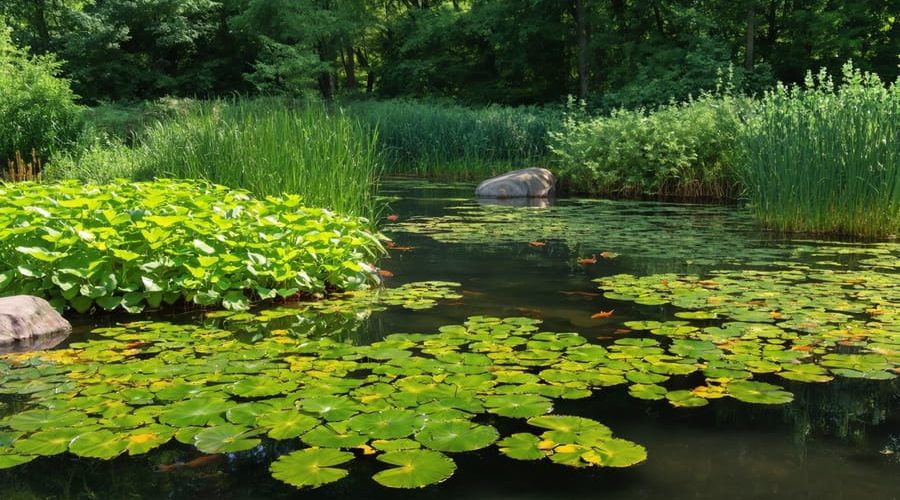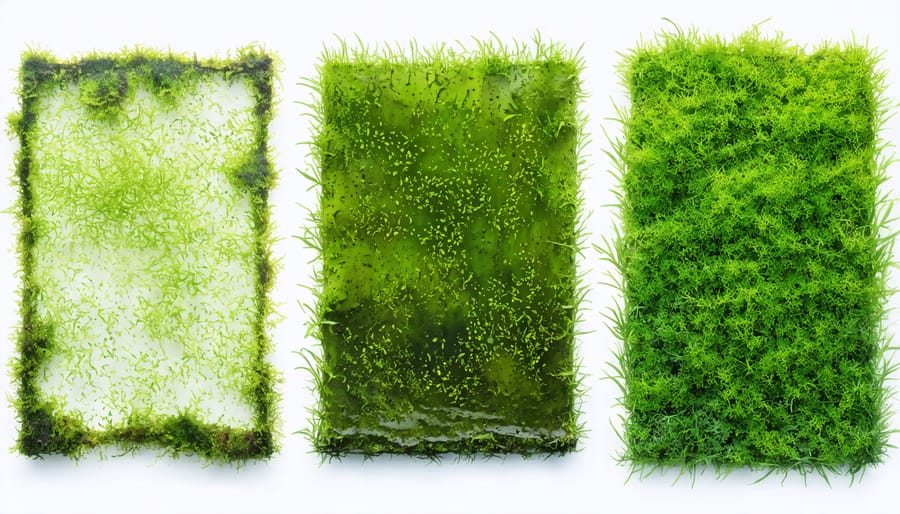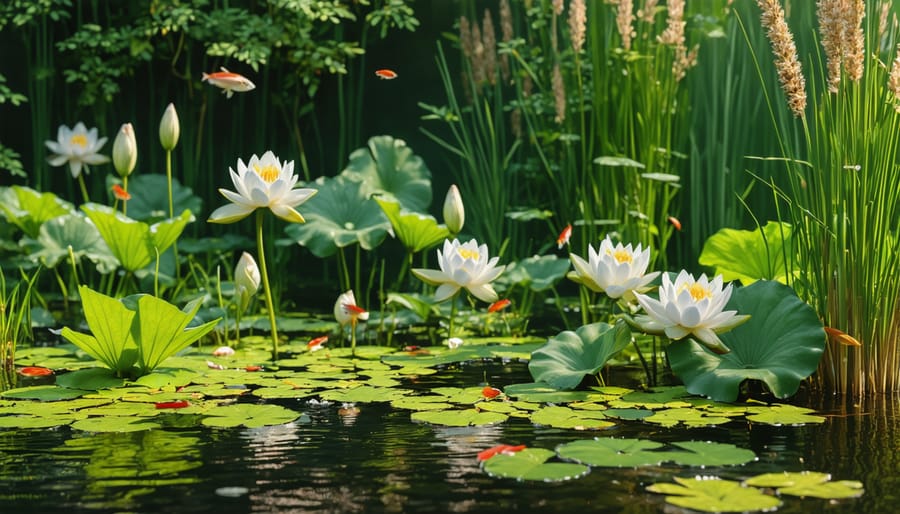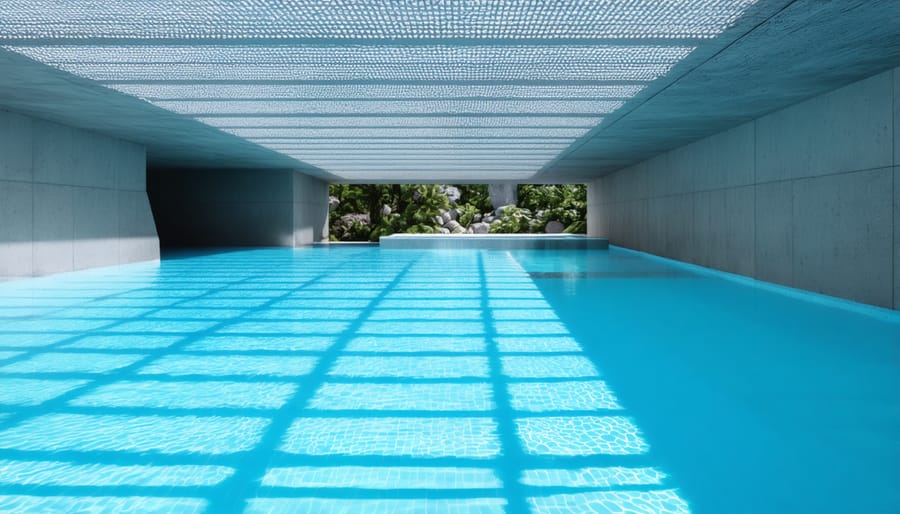
Smart Solutions That Keep Your Pond Pristine (Without Harsh Chemicals)
Managing your aquatic ecosystem starts with precise water quality monitoring – test pH, ammonia, and dissolved oxygen levels weekly to catch potential issues before they become problems. Create a natural filtration system using beneficial bacteria and aquatic plants like water lilies and hornwort, which absorb excess nutrients while providing essential habitat for fish and beneficial insects. Establish a balanced food web by introducing native fish species and allowing natural predator-prey relationships to develop, reducing the need for chemical interventions.
The key to sustainable pond management lies in prevention rather than reaction. Installing an appropriately sized aeration system maintains healthy oxygen levels throughout the water column, while strategic placement of underwater structures creates safe havens for smaller organisms. Regular removal of fallen leaves and debris, combined with careful management of surrounding vegetation, prevents excess nutrient buildup that could lead to algae blooms.
Modern aquatic ecosystem management embraces both time-tested wisdom and innovative solutions. Whether you’re maintaining a backyard pond or overseeing a larger water feature, success comes from understanding and working with nature’s own systems rather than against them. This approach not only creates a more stable environment but also reduces long-term maintenance requirements while supporting local biodiversity.
Common Aquatic Pests That Threaten Your Pond’s Balance
Algae Varieties and Their Effects
Different types of algae can appear in your pond, each presenting unique challenges for water garden enthusiasts. Green water algae are microscopic floating organisms that turn your pond into what looks like pea soup. While frustrating, they’re actually less harmful than their stringy cousins, filamentous algae, which form those unsightly green mats on the water’s surface.
Blanketweed, a common type of filamentous algae, can quickly take over your pond, wrapping around plants and clogging filters. Blue-green algae, despite its name, is actually a form of bacteria that can be toxic to fish and pets. You might also encounter brown algae, which often appears as a slimy coating on rocks and liner walls, particularly in new ponds.
Each variety requires different management approaches. What works for floating algae might not be effective for blanketweed. The good news is that some algae are beneficial in small amounts, providing food for fish and helping to maintain water quality. The key is finding the right balance for your pond’s ecosystem.

Invasive Plants and Weeds
Dealing with invasive aquatic plants is one of the biggest challenges pond owners face. Common troublemakers include duckweed, which can quickly blanket your pond’s surface, and water hyacinth, known for its rapid spread and thick root systems. These uninvited guests compete with native plants for nutrients and can significantly reduce oxygen levels in your pond.
Water lettuce and Eurasian watermilfoil are particularly aggressive invaders that can form dense mats, making it difficult for fish to swim and native plants to thrive. They also create perfect breeding grounds for mosquitoes and can clog filtration systems.
The key to managing these unwanted visitors is early detection and swift action. Regular monitoring of your pond’s edges and surface will help you spot new invasive species before they become established. Remember, prevention is always easier than cure – carefully inspect any new plants before adding them to your pond, and consider quarantining them in a separate container for a few weeks to ensure they’re free from hitchhiking invasive species.
Natural Solutions That Actually Work

Beneficial Plants That Fight Back
Nature has provided us with some amazing aquatic plants that can help control unwanted pests and algae in your pond while adding beauty to your water garden. These beneficial plants work by competing for nutrients and space, making it harder for nuisance species to take hold.
Water lilies are excellent natural fighters, as their large floating leaves shade the water and prevent excess algae growth. They consume nutrients that algae would otherwise use, creating a natural balance in your pond. Plus, they provide beautiful blooms throughout the season!
Hornwort, also known as coontail, is a submerged plant that releases chemicals that inhibit algae growth. It’s like having an underwater security guard protecting your pond’s ecosystem. This fast-growing plant also provides shelter for beneficial insects and small fish that help control mosquito larvae.
Rushes and cattails are natural filters that absorb excess nutrients through their roots. Plant them along the edges of your pond where they’ll catch and filter runoff before it enters the water. These tall plants also create natural barriers against unwanted visitors like geese.
For smaller ponds, consider adding floating plants like duckweed or water hyacinth. While you’ll need to manage their growth, these plants are incredibly efficient at removing excess nutrients from the water. They work like tiny vacuum cleaners, sucking up the materials that would otherwise feed problematic algae.
Remember to maintain a good balance – aim to cover about 60% of your pond’s surface with a combination of these beneficial plants. This allows enough light penetration while maximizing their pest-fighting benefits.
Fish and Other Biological Controls
When it comes to maintaining a healthy aquatic ecosystem, one of the most effective biological control methods is introducing fish and other beneficial organisms. Fish like koi and goldfish not only add beauty to your pond but also help control mosquito larvae and other unwanted insects. For more aggressive algae control, grass carp can be excellent additions, as they naturally feed on various aquatic plants and help maintain balance.
Consider adding freshwater mussels or snails to your ecosystem. These natural cleaners filter water and consume decaying plant matter, helping to keep your pond crystal clear. Dragonfly nymphs and water beetles are also fantastic predators that control mosquito populations and other small aquatic pests.
When selecting fish for biological control, it’s important to match species to your pond’s size and existing ecosystem. Start with a small number and gradually increase the population as needed. Remember that overfeeding fish can lead to water quality issues, so maintain a careful balance.
For best results, combine different types of biological controls. For example, pairing bottom-feeding fish with surface skimmers like mosquito fish creates a more comprehensive pest management system. Just be sure to research compatibility between species before introducing new creatures to your pond.
Monitor your biological control population regularly and adjust as needed. Some species may need to be replaced periodically, while others will naturally maintain their numbers. This natural approach to pond management typically requires more patience than chemical treatments but offers long-term, sustainable results.
Smart Technology in Pond Management
Advanced Filtration Systems
Modern filtration systems have revolutionized how we maintain healthy aquatic ecosystems. Today’s advanced filters combine multiple stages of filtration – mechanical, biological, and chemical – into single, efficient units that keep water crystal clear while supporting beneficial bacteria.
One of the most exciting innovations is the pressurized bio-filter, which processes water through dense foam layers and specialized bio-media. These systems can handle large volumes of water while taking up minimal space around your pond. They’re particularly effective at removing fine particles that traditional filters might miss.
UV clarifiers have also seen significant improvements. The latest models incorporate smart sensors that adjust UV intensity based on water flow and clarity, maximizing effectiveness while reducing energy consumption. When combined with traditional biological filtration, these systems can eliminate green water issues within days.
For DIY enthusiasts, modular filtration systems offer fantastic flexibility. You can start with basic mechanical filtration and add components like phosphate removers or protein skimmers as your needs evolve. Many of these systems now come with convenient backwash features that make maintenance a breeze.
The newest generation of pond filters also includes built-in monitoring systems that alert you when maintenance is needed or water parameters shift outside optimal ranges. Some even connect to smartphone apps, letting you track your pond’s health from anywhere.
These advancements mean clearer water, healthier fish, and less time spent on maintenance – exactly what every pond owner dreams of!

UV and Sonic Solutions
UV and sonic technologies offer modern, eco-friendly solutions for managing aquatic ecosystems without harsh chemicals. UV clarifiers use ultraviolet light to eliminate single-celled algae and harmful microorganisms as water passes through the unit. They’re especially effective for maintaining crystal-clear pond water and reducing the risk of waterborne diseases that can affect fish and plants.
Sonic devices, on the other hand, emit ultrasonic waves that disrupt algae’s cellular structure and prevent their growth. These devices are particularly useful in larger ponds and water features where traditional treatments might be impractical. While they won’t eliminate existing algae, they’re excellent at preventing new growth when used consistently.
The best part about these solutions is their hands-off nature – once installed, they work continuously with minimal maintenance. UV clarifiers typically need bulb replacement annually, while sonic devices run for years with just occasional cleaning. Both options are safe for fish, plants, and beneficial bacteria that keep your pond healthy.
For optimal results, consider combining both technologies. Install a UV clarifier in your filtration system for immediate water clarity, and use a sonic device for long-term algae prevention. Remember that these solutions work best as part of a comprehensive pond management strategy that includes proper filtration and regular maintenance.
Preventive Maintenance Calendar
Seasonal Monitoring Tips
Each season brings unique challenges and opportunities for your aquatic ecosystem. In spring, focus on water quality testing as temperatures rise and life begins to stir. Watch for algae blooms, which commonly occur as nutrients become more active. Check your filtration systems and remove any debris that accumulated over winter.
Summer requires vigilant monitoring of water temperatures and oxygen levels, especially during heat waves. Keep an eye on water levels, as evaporation increases during hot weather. Watch for signs of stress in fish, such as gasping at the surface, which might indicate low oxygen levels. Regular checks of plant growth are essential to prevent overcrowding.
Fall is the time to monitor falling leaves and organic matter. Remove dead plant material before it sinks and decomposes, which can affect water quality. Keep track of water temperature changes as they begin to drop, and adjust feeding schedules accordingly. Check equipment that will need to run through winter.
Winter monitoring focuses on maintaining ice-free areas if you live in cold regions. Watch for signs of ice damage to equipment and ensure water continues flowing. While biological activity slows down, don’t completely stop monitoring water quality. Keep an eye on snow accumulation on frozen surfaces, as too much weight can stress the ecosystem.
Remember that these seasonal patterns may vary depending on your climate zone, but maintaining regular monitoring habits throughout the year is key to a healthy aquatic ecosystem.
Early Warning Signs
Keeping your aquatic ecosystem healthy starts with recognizing potential problems early. Just like a doctor looks for symptoms in patients, you’ll want to watch for tell-tale signs that your pond might need attention.
One of the most common warning signs is cloudy or discolored water. Clear water should let you see at least 12-18 inches deep. If visibility decreases, it could indicate an algae bloom or excess nutrients. Watch for sudden changes in water color too – green usually means algae, while brown or yellow might suggest tannins from decomposing leaves.
Pay attention to your fish’s behavior. If they’re gasping at the surface or staying near water features, oxygen levels might be low. Unusual swimming patterns or rubbing against surfaces could indicate parasites or poor water quality.
Plant health is another key indicator. Yellowing leaves, stunted growth, or dying plants often signal nutrient imbalances or poor water conditions. Keep an eye out for excessive algae growth on plant leaves and pond surfaces.
Unpleasant odors shouldn’t be ignored. A healthy pond has a fresh, earthy smell. If you notice fishy, rotten, or sewage-like odors, something’s wrong with your water chemistry or filtration system.
Listen to your pond too. Changes in pump sounds or water flow could mean equipment needs maintenance. Regular monitoring of these signs helps you catch and address issues before they become serious problems.
Managing an aquatic ecosystem is both a rewarding journey and a vital responsibility. Throughout this guide, we’ve explored the essential elements that make these water-based environments thrive, from maintaining proper water quality to selecting the right mix of plants and wildlife. Remember that successful ecosystem management is all about finding the right balance – between natural processes and human intervention, between aesthetics and functionality.
By implementing the strategies we’ve discussed, you can create a sustainable aquatic habitat that brings joy for years to come. Start with regular water testing and maintenance, introduce beneficial plants gradually, and always consider the long-term impact of any changes you make. Natural solutions, like using beneficial bacteria or adding aquatic plants for filtration, often prove more effective than quick chemical fixes.
Don’t forget that every aquatic ecosystem is unique, and it may take some time to find what works best for yours. Be patient, observe changes closely, and adjust your approach as needed. The effort you invest in maintaining your water feature will be rewarded with a vibrant, self-sustaining ecosystem that enhances your outdoor space.
Whether you’re managing a small backyard pond or a larger water feature, your role as a steward of this miniature ecosystem makes a real difference. By choosing sustainable practices and maintaining regular care routines, you’re not just creating a beautiful water feature – you’re contributing to local biodiversity and environmental health.
